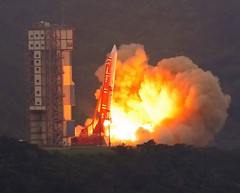

Suzaku is a joint Japanese-US satellite whose mission is to study X-rays emitted by objects in the universe, such as stars, galaxies, and black holes. X-rays are a form of electromagnetic radiation, and many objects in our universe emit them.
Suzaku launched from Uchinoura, Japan on July 10, 2005. Before launch it was called Astro-E2, and the name was changed to Suzaku shortly after the successful launch.
Suzaku's four CCD cameras for low-energy X-rays and detector for high-energy X-rays continue to study the X-ray sky. In scientists' words, Suzaku is designed for “broad-band, high-sensitivity, high-resolution” spectroscopy. This capability will allow astronomers to answer questions in X-ray astronomy that they have not been able to before.
The Suzaku satellite originally had an instrument for looking at very small changes in X-ray energies; however, this instrument lost all of it's coolant shortly after launch. This loss and the “2” in “Astro-E2” speak to the difficult realities scientists and engineers face when attempting to construct and operate rocket-borne satellites.